Tectono-Paleogeographic Impact on the Permian Depositional Environment and Provenance around the Chaiwopu Depression in the Southern Junggar Basin, NW China
Abstract
:1. Introduction
2. Geologic Background
2.1. Tectonic Setting
2.2. General Stratigraphy of Permian Strata
3. Materials and Methods
3.1. Field Observation and Sampling
3.2. Analytical Methods
4. Lithological, Mineralogical, and Sedimentary Descriptions
4.1. Hongyanchi Outcrop
4.2. Heigou Outcrop
4.3. Dagangou Outcrop
4.4. Aiwergou Outcrop
4.5. Hougou Outcrop
4.6. Tarlang Outcrop
5. Geochemical Characteristics
5.1. Tectonic Setting Analysis
5.2. Sediment Source Analysis
5.3. Weathering and Maturity Analysis
6. Discussion
6.1. Depositional Environment
6.2. Provenance
7. Conclusions
Supplementary Materials
Author Contributions
Funding
Data Availability Statement
Acknowledgments
Conflicts of Interest
Appendix A
| Outcrop | Strat. | Formation | Sample | Lithology | Major Minerals |
|---|---|---|---|---|---|
| Hong -yanchi | MP | Jingjingzigou | HYC-02 | Lithic sandstone | quartz, plagioclase (albite) |
| HYC-04 | Lithic sandstone | ||||
| HYC-05 | Lithic sandstone with oil | ||||
| HYC-09 | Lithic sandstone | ||||
| HYC-10 | Breccia sandstone | ||||
| HYC-11 | Lithic sandstone | ||||
| Heigou | MP | Jingjingzigou | HEIG-03 | Siltstone with tuff | quartz, plagioclase (albite), orthoclase |
| HEIG-05 | Lithic siltstone | ||||
| Lucaogou | HEIG-07 | Mudstone | quartz, plagioclase (albite, anorthite), orthoclase, calcite | ||
| Dagan -gou | LP | Tashkura | DGG-01 | Altered diorite dike | plagioclase (albite), orthoclase, hornblende, pyroxene, chlorite, calcite, dolomite |
| DGG-03 | Tuff | quartz, plagioclase (albite), orthoclase, calcite | |||
| DGG-06 | Tuffaceous silt/sandstone | ||||
| MP | Wulabo | DGG-07 | Sandstone | quartz, plagioclase (albite), calcite | |
| Jingjingzigou | DGG-10 | Coarse grained diorite | |||
| Aiwer -gou | MP | AWG-03 | Micritic limestone | calcite, quartz, plagioclase (albite), ankerite | |
| AWG-05 | Lithic siltstone | ||||
| AWG-06 | Lithic siltstone | ||||
| Hougou | LP | HOUG-02 | Diorite porphyrite | plagioclase (albite, anorthite), hornblende, pyroxene | |
| HOUG-03 | Rhyolite | ||||
| HOUG-04 | Andesite | plagioclase (albite, anorthite), hornblende, pyroxene, biotite | |||
| HOUG-05 | Granular pyroclastics | quartz, plagioclase (albite), hematite | |||
| Tarlang | MP | TAR-07 | Detrital limestone |
References
- Chen, X.; Shu, L.; Santosh, M. Late Paleozoic post-collisional magmatism in the Eastern Tianshan Belt, Northwest China: New insights from geochemistry, geochronology and petrology of bimodal volcanic rocks. Lithos 2011, 127, 581–598. [Google Scholar] [CrossRef]
- Jahn, B.; Wu, F.; Chen, B. Massive granitoid generation in Central Asia: Nd isotope evidence and implication for continental growth in the Phanerozoic. Episodes 2000, 23, 82–92. [Google Scholar] [CrossRef] [Green Version]
- Long, X.; Yuan, C.; Sun, M.; Xiao, W.; Wang, Y.; Cai, K.; Jiang, Y. Geochemistry and Nd isotopic composition of the Early Paleozoic flysch sequence in the Chinese Altai, Central Asia: Evidence for a northward-derived mafic source and insight into Nd model ages in accretionary orogen. Gondwana Res. 2012, 22, 554–566. [Google Scholar] [CrossRef]
- Memtimin, M.; Pe-Piper, G.; Piper, D.J.W.; Guo, Z.; Zhang, Y. Carboniferous arc-related volcanism in SW Bogda Mountain, Northwest China, and its implications for regional tectonics. Lithos 2020, 360–361, 105413. [Google Scholar] [CrossRef]
- Sengör, A.M.C.; Natal’in, B.A.; Burtman, V.S. Evolution of the Altaid Tectonic Collage and Paleozoic Crustal growth in Eurasia. Nature 1993, 364, 299–307. [Google Scholar] [CrossRef]
- Shu, L.; Wang, B.; Zhu, W.; Guo, Z.; Charvet, J.; Zhang, Y. Timing of initiation of extension in the Tianshan, based on structural, geochemical and geochronological analyses of bimodal volcanism and olistostrome in the Bogda Shan (NW China). Int. J. Earth Sci. 2011, 100, 1647–1663. [Google Scholar] [CrossRef] [Green Version]
- Simonov, V.; Mikolaichuk, A.; Safonova, I.; Kotlyarov, A.; Kovyazin, S. Late Paleozoic-Cenozoic intra-plate continental basaltic magmatism of the Tienshan-Junggar region in the SW Central Asian Orogenic Belt. Gondwana Res. 2015, 27, 1646–1666. [Google Scholar] [CrossRef]
- Wali, G.; Wang, B.; Cluzel, D.; Zhong, L. Carboniferous—Early Permian magmatic evolution of the Bogda range (Xinjiang, NW China): Implications for the late paleozoic accretionary tectonics of the SW central Asian orogenic belt. J. Asian Earth Sci. 2018, 153, 238–251. [Google Scholar] [CrossRef]
- Wang, Q.; Zhao, G.; Han, Y.; Yao, J. Detrital zircon constraints on late Paleozoic tectonism of the Bogda region (NW China) in the southern Central Asian Orogenic Belt. Geosci. Front. 2020, 11, 1533–1548. [Google Scholar] [CrossRef]
- Windley, B.F.; Alexeiev, D.; Xiao, W.J.; Kroner, A.; Badarch, G. Tectonic models for accretion of the Central Asian Orogenic Belt. J. Geol. Soc. 2007, 164, 31–47. [Google Scholar] [CrossRef] [Green Version]
- Xia, L.-Q.; Xia, Z.-C.; Xu, X.-Y.; Li, X.-M.; Ma, Z.-P. Relative contributions of crust and mantle to the generation of the Tianshan Carboniferous rift-related basic lavas, northwestern China. J. Asian Earth Sci. 2008, 31, 357–378. [Google Scholar] [CrossRef]
- Xia, L.; Li, X. Revisiting the tectonic setting of the Carboniferous volcanic rocks in the Chinese Tianshan and its neighboring areas. Gondwana Res. 2020, 84, 1–19. [Google Scholar] [CrossRef]
- Xiao, W.; Han, C.; Yuan, C.; Sun, M.; Lin, S.; Chen, H.; Li, Z.; Li, J.; Sun, S. Middle Cambrian to Permian subduction-related accretionary orogenesis of northern Xinjiang, NW China: Implications for the tectonic evolution of central Asia. J. Asian Earth Sci. 2008, 32, 102–117. [Google Scholar] [CrossRef]
- Xie, W.; Luo, Z.Y.; Xu, Y.G.; Chen, Y.B.; Hong, L.B.; Ma, L.; Ma, Q. Petrogenesis and geochemistry of the late Carboniferous rear-arc (or back-arc) pillow basaltic lava in the Bogda Mountains, Chinese North Tianshan. Lithos 2016, 244, 30–42. [Google Scholar] [CrossRef]
- Xie, W.; Xu, Y.G.; Luo, Z.Y.; Chen, Y.B.; Liu, H.Q.; Hong, L.B.; Ma, L. Petrogenesis and geodynamic implications of the late Carboniferous felsic volcanics in the Bogda belt, Chinese Northern Tianshan. Gondwana Res. 2016, 39, 165–179. [Google Scholar] [CrossRef]
- Zhang, X.; Zhao, G.; Eizenhöfer, P.R.; Sun, M.; Han, Y.; Hou, W.; Liu, D.; Wang, B.; Liu, Q.; Xu, B. Latest Carboniferous closure of the Junggar Ocean constrained by geochemical and zircon U–Pb–Hf isotopic data of granitic gneisses from the Central Tianshan block, NW China. Lithos 2015, 238, 26–36. [Google Scholar] [CrossRef]
- Carroll, A.R.; Liang, Y.; Graham, S.A.; Xiao, X.; Hendrix, M.S.; Chu, J.; McKnight, C.L. Junggar basin, northwest China: Trapped Late Paleozoic Ocean. Tectonophysics 1990, 181, 1–14. [Google Scholar] [CrossRef]
- Carroll, A.R.; Graham, S.A.; Hendrix, M.S.; Ying, D.; Zhou, D. Late Paleozoic tectonic amalgamation of northwestern China Sedimentary record of the northern Tarim, northwestern Turpan, and southern Junggar Basins. GSA Bull. 1995, 107, 571–594. [Google Scholar] [CrossRef]
- Gao, Y.; Huang, H.; Tao, H.; Carroll, A.R.; Qin, J.; Chen, J.; Yuan, X.; Wang, C. Paleoenvironmental setting, mechanism and consequence of massive organic carbon burial in the Permian Junggar Basin, NW China. J. Asian Earth Sci. 2020, 194, 104222. [Google Scholar] [CrossRef]
- Liu, D.; Zhang, C.; Yao, E.; Song, Y.; Jiang, Z.; Luo, Q. What generated the Late Permian to Triassic unconformities in the southern Junggar Basin and western Turpan Basin; tectonic uplift, or increasing aridity? Palaeogeogr. Palaeoclimatol. Palaeoecol. 2017, 468, 1–17. [Google Scholar] [CrossRef]
- Wartes, M.A.; Carroll, A.R.; Greene, T.J.; Cheng, K.; Ting, H. Permian Lacustrine Deposits of Northwest China. In Lake Basins through Space and Time: AAPG, Studies in Geology; Gierlowski-Kordesch, E., Kelts, K., Eds.; AAPG, 2000; Volume 46, pp. 123–132. Available online: http://www.geology.wisc.edu/~carroll/publications/pdf/Wartes%20et%20al.,%202000.pdf (accessed on 15 August 2021).
- Wartes, M.A.; Carroll, A.R.; Greene, T.J. Permian sedimentary record of the Turpan-Hami basin and adjacent regions, northwest China: Constraints on post-amalgamation tectonic evolution. GSA Bull. 2002, 114, 131–152. [Google Scholar] [CrossRef] [Green Version]
- Carroll, A.R.; Brassell, S.C.; Graham, S.A. Upper Permian lacustrine oil shales, Southern Junggar Basin, Northwest China. AAPG Bull. 1992, 76, 1874–1902. [Google Scholar]
- Carroll, A.R. Upper Permian lacustrine organic facies evolution, Southern Junggar Basin, NW China. Org. Chem. 1998, 28, 649–667. [Google Scholar] [CrossRef]
- Huang, H.P. The Nature and Origin of Petroleum in the Chaiwopu Sub-Basin (Junggar Basin), NW China. J. Pet. Geol. 2000, 23, 193–220. [Google Scholar] [CrossRef]
- Fang, Y.; Wu, C.; Wang, Y.; Hou, K.; Guo, Z. Topographic evolution of the Tianshan Mountains and their relation to the Junggar and Turpan Basins, Central Asia, from the Permian to the Neogene. Gondwana Res. 2019, 75, 47–67. [Google Scholar] [CrossRef]
- Li, Y.; Yue, W.; Yu, X.; Huang, X.; Yao, Z.; Song, J.; Shan, X.; Yu, X.; Yang, S. Tectonic Evolution of the West Bogeda: Evidences from Zircon U-Pb Geochronology and Geochemistry Proxies, NW China. Minerals 2020, 10, 341. [Google Scholar] [CrossRef] [Green Version]
- Obrist-Farner, J.; Yang, W. Provenance and depositional conditions of fluvial conglomerates and sandstones and their controlling processes in a rift setting, mid-Permian lower and upper Quanzijie low order cycles, Bogda Mountains, NW China. J. Asian Earth Sci. 2017, 138, 317–340. [Google Scholar] [CrossRef]
- Shi, Y.; Ji, H.; Yu, J.; Xiang, P.; Yang, Z.; Liu, D. Provenance and sedimentary evolution from the Middle Permian to Early Triassic around the Bogda Mountain, NW China: A tectonic inversion responding to the consolidation of Pangea. Mar. Pet. Geol. 2020, 114, 104169. [Google Scholar] [CrossRef]
- Tang, W.; Zhang, Z.; Li, J.; Li, K.; Chen, Y.; Guo, Z. Late Paleozoic to Jurassic tectonic evolution of the Bogda area (northwest China): Evidence from detrital zircon U–Pb geochronology. Tectonophysics 2014, 626, 144–156. [Google Scholar] [CrossRef]
- Thomas, S.G.; Tabor, N.J.; Yang, W.; Myers, T.S.; Yang, Y.; Wang, D. Palaeosol stratigraphy across the Permian–Triassic boundary, Bogda Mountains, NW China: Implications for palaeoenvironmental transition through earth’s largest mass extinction. Palaeogeogr. Palaeoclimatol. Palaeoecol. 2011, 308, 41–64. [Google Scholar] [CrossRef]
- Wang, J.; Cao, Y.-C.; Wang, X.-T.; Liu, K.-Y.; Wang, Z.-K.; Xu, Q.-S. Sedimentological constraints on the initial uplift of the West Bogda Mountains in Mid-Permian. Sci. Rep. 2018, 8, 1453. [Google Scholar] [CrossRef] [Green Version]
- Wang, J.; Wu, C.; Li, Z.; Zhu, W.; Zhou, T.; Wu, J.; Wang, J. The tectonic evolution of the Bogda region from Late Carboniferous to Triassic time: Evidence from detrital zircon U–Pb geochronology and sandstone petrography. Geol. Mag. 2018, 155, 1063–1088. [Google Scholar] [CrossRef]
- Wang, J.; Wu, C.; Zhou, T.; Zhu, W.; Zhou, Y.; Jiang, X.; Yang, D. Source-to-sink analysis of a transtensional rift basin from syn-rift to uplift stages. J. Sediment. Res. 2019, 89, 335–352. [Google Scholar] [CrossRef]
- Yang, W.; Feng, Q.; Liu, Y.; Tabor, N.; Miggins, D.; Crowley, J.L.; Lin, J.; Thomas, S. Depositional environments and cyclo- and chronostratigraphy of uppermost Carboniferous–Lower Triassic fluvial–lacustrine deposits, southern Bogda Mountains, NW China—A terrestrial paleoclimatic record of mid-latitude NE Pangea. Glob. Planet. Chang. 2010, 73, 15–113. [Google Scholar] [CrossRef]
- Zhao, R.; Zhang, J.; Zhou, C.; Zhang, Z.; Chen, S.; Stockli, D.F.; Olariu, C.; Steel, R.; Wang, H. Tectonic evolution of Tianshan-Bogda-Kelameili mountains, clastic wedge basin infill and chronostratigraphic divisions in the source-to-sink systems of Permian-Jurassic, southern Junggar Basin. Mar. Pet. Geol. 2020, 114, 104200. [Google Scholar] [CrossRef]
- Bhatia, M.R. Rare earth element geochemistry of Australian Paleozoic graywackes and mudrocks: Provenance and tectonic control. Sediment. Geol. 1985, 45, 97–113. [Google Scholar] [CrossRef]
- Bhatia, M.R.; Crook, K.A.W. Trace element characteristics of graywackes and tectonic setting discrimination of sedimentary basins. Contrib. Mineral. Petrol. 1986, 92, 181–193. [Google Scholar] [CrossRef]
- Cox, R.; Lowe, D.R.; Cullers, R.L. The influence of sediment recycling and basement composition on evolution of mudrock chemistry in the southwestern United States. Geochim. Cosmochim. Acta 1995, 59, 2919–2940. [Google Scholar] [CrossRef]
- Dickinson, W.R. Interpreting provenance relations from detrital modes of Sandstones. In Provenance of Arenites; Zuma, G.G., Ed.; Reidel: Dordrecht, The Netherlands, 1985; pp. 333–361. [Google Scholar]
- Fedo, C.M.; Nesbitt, H.W.; Young, G.M. Unrevelling the effects of potassium metasomatism in sedimentary rocks and paleosols, with implications for paleo-weathering conditions and provenance. Geology 1995, 23, 921–924. [Google Scholar] [CrossRef]
- Floyd, P.A.; Winchester, J.A.; Park, R.G. Geochemistry and tectonic setting of Lewisian clastic metasediments from the early Proterozoic Lock Marie Group of Gairloch, Scotland. Precambrian Res. 1989, 45, 203–214. [Google Scholar] [CrossRef]
- Herron, M.M. Geochemical classification of terrigenous sands and shales from core or log data. J. Sediment. Petrol. 1988, 58, 820–829. [Google Scholar] [CrossRef]
- Le Bas, M.J.; Le Maitre, R.W.; Streckeisen, A.; Zanettin, B. A chemical classification of volcanic rocks based on the total alkali-silica diagram. J. Petrol. 1986, 27, 745–750. [Google Scholar] [CrossRef]
- McLennan, S.M.; McLennan, S.M.; Hemming, S.; McDaniel, D.K.; Hanson, G.N. Geochemical approaches to sedimentation, provenance and tectonics. In Processes Controlling the Composition of Clastic Sediments; Johansson, M.J., Basu, A., Eds.; Geological Society America: Boulder, CO, USA, 1993; Volume 284, pp. 21–40. [Google Scholar] [CrossRef]
- Nesbitt, H.W.; Young, G.M. Early Proterozoic climates and plate motions inferred from major element chemistry of lutites. Nature 1982, 299, 715–717. [Google Scholar] [CrossRef]
- Pearce, J.A. Trace element characteristics of lavas from destructive plate boundaries. In Andesites; Thorps, R.S., Ed.; John Wiley and Sons: New York, NY, USA, 1982; pp. 525–548. [Google Scholar]
- Roser, B.P.; Korsch, R.J. Determination of tectonic setting of sandstone–mudstone suites using SiO2 content and K2O/Na2O ratio. J. Geol. 1986, 94, 635–650. [Google Scholar] [CrossRef]
- Roser, B.P.; Cooper, R.A.; Nathan, S.; Tulloch, A.J. Reconnaissance sandstone geochemistry, provenance, and tectonic setting of the lower Paleozoic terranes of the West Coast and Nelson, New Zealand. N. Z. J. Geol. Geophys. 1996, 39, 1–16. [Google Scholar] [CrossRef]
- Roser, B.P.; Korsch, R.J. Provenance signatures of sandstone–mudstone suites determined using discrimination function analysis of major-element data. Chem. Geol. 1988, 67, 119–139. [Google Scholar] [CrossRef]
- Suttner, L.J.; Dutta, P.K. Alluvial sandstone composition and paleoclimate, framework mineralogy. J. Sediment. Petrol. 1986, 56, 329–345. [Google Scholar] [CrossRef]
- Taylor, S.R.; McLennan, S.M. The Continental Crust: Its Composition and Evolution; Blackwell Scientific Publications: Oxford, UK, 1985; p. 312. [Google Scholar]
- Verma, S.P.; Armstrong-Altrin, J.S. New multi-dimensional diagrams for tectonic discrimination of siliciclastic sediments and their application to Precambrian basins. Chem. Geol. 2013, 355, 117–133. [Google Scholar] [CrossRef]
- Dobretsov, N.L.; Berzin, N.A.; Buslov, M.M. Opening and tectonic evolution of the Paleo-Asian Ocean. Int. Geol. Rev. 1995, 37, 335–360. [Google Scholar] [CrossRef]
- Safonova, I.; Kotlyarov, A.; Krivonogov, S.; Xiao, W. Intra-oceanic arcs of the Paleo-Asian ocean. Gondwana Res. 2017, 50, 167–194. [Google Scholar] [CrossRef] [Green Version]
- Wan, B.; Li, S.; Xiao, W.; Windley, B.F. Where and when did the Paleo-Asian ocean form? Precambrian Res. 2018, 317, 241–252. [Google Scholar] [CrossRef]
- Haq, B.U.; Schutter, S.R. A Chronology of Paleozoic Sea-Level Changes. Science 2008, 322, 64–68. [Google Scholar] [CrossRef]
- BGMRXUAR (Bureau of Geology and Mineral Resources of Xinjiang Uygur Autonomous Region). Regional Geology of Xinjiang Uygur Autonomous Region; Geological Publishing House: Beijing, China, 1993; p. 841, (in Chinese with English summary). [Google Scholar]
- Xue, D.; Wang, H.; Liu, Y.; Xie, L.; Shen, P. An Improved Procedure for the Determination of Ferrous Iron Mass Fraction in Silicate Rocks Using a Schlenk Line-Based Digestion Apparatus to Exclude Oxygen. Geostand. Geoanalytical Res. 2017, 41, 411–425. [Google Scholar] [CrossRef]
- Bouma, A.H. Sedimentology of Some Flysch Deposits: A Graphic Approach to Facies Interpretation; Elsevier Publishing Company: Amsterdam, The Netherlands; New York, NY, USA, 1962; p. 168. [Google Scholar]
- Babechuk, M.G.; Widdowson, M.; Kamber, B.S. Quantifying chemical weathering intensity and trace element release from two contrasting basalt profiles, Deccan Traps, India. Chem. Geol. 2014, 363, 56–75. [Google Scholar] [CrossRef]
- Lee, E.Y.; Tejada, M.L.G.; Song, I.; Chun, S.S.; Gier, S.; Riquier, L.; White, L.T.; Schnetger, B.; Brumsack, H.-J.; Jones, M.M.; et al. Petrophysical Property Modifications by Alteration in a Volcanic Sequence at IODP Site U1513, Naturaliste Plateau. J. Geophys. Res. Solid Earth 2021, 126, e2020JB021061. [Google Scholar] [CrossRef]
- Morgan, J.; Moore, K.; Moore, G.F.; Clague, D.A. Slope failure and volcanic spreading along the submarine south flank of Kilauea volcano, Hawaii. J. Geophys. Res. Solid Earth 2003, 108, 2415. [Google Scholar] [CrossRef] [Green Version]
- Muravchik, M.; Bilmes, A.; D’Elia, L.; Franzese, J.R. Alluvial fan deposition along a rift depocentre border from the Neuquén Basin, Argentina. Sediment. Geol. 2014, 301, 70–89. [Google Scholar] [CrossRef]
- Gawthorpe, R.L.; Leeder, M.R. Tectono-sedimentary evolution of active extensional basins. Basin Res. 2000, 12, 195–218. [Google Scholar] [CrossRef]
- Alexander, J.; Leeder, M.R. Geomorphology and surface tilting in an active extensional basin, SW Montana, USA. J. Geol. Soc. 1990, 147, 461–467. [Google Scholar] [CrossRef]
- Kim, Y.; Huh, M.; Lee, E.Y. Numerical Modelling to Evaluate Sedimentation effects on Heat Flow and Subsidence during Continental Rifting. Geosciences 2020, 10, 451. [Google Scholar] [CrossRef]
- Zou, C.; Wang, L.; Li, Y.; Tao, S.; Hou, L. Deep-lacustrine transformation of sandy debrites into turbidites, Upper Triassic, Central China. Sediment. Geol. 2012, 265–266, 143–155. [Google Scholar] [CrossRef]
- Knierzinger, W.; Wagreich, M.; Palzer-Khomenko, M.; Gier, S.; Meszar, M.; Lee, E.Y.; Koukal, V.; Strauss, P. Provenance and palaeogeographic evolution of Lower Miocene sediments in the eastern North Alpine Foreland Basin. Swiss J. Geosci. 2019, 112, 269–286. [Google Scholar] [CrossRef]

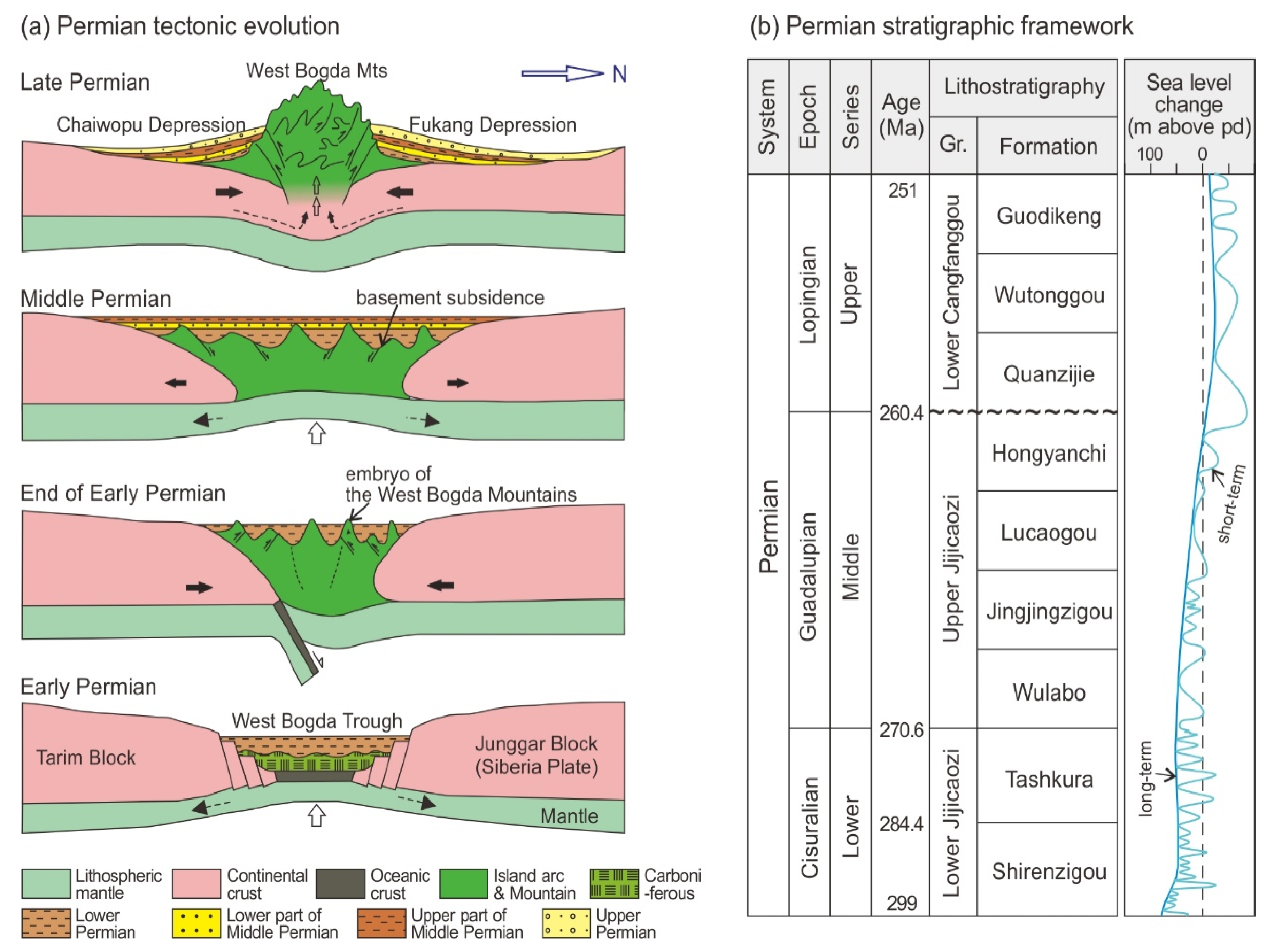
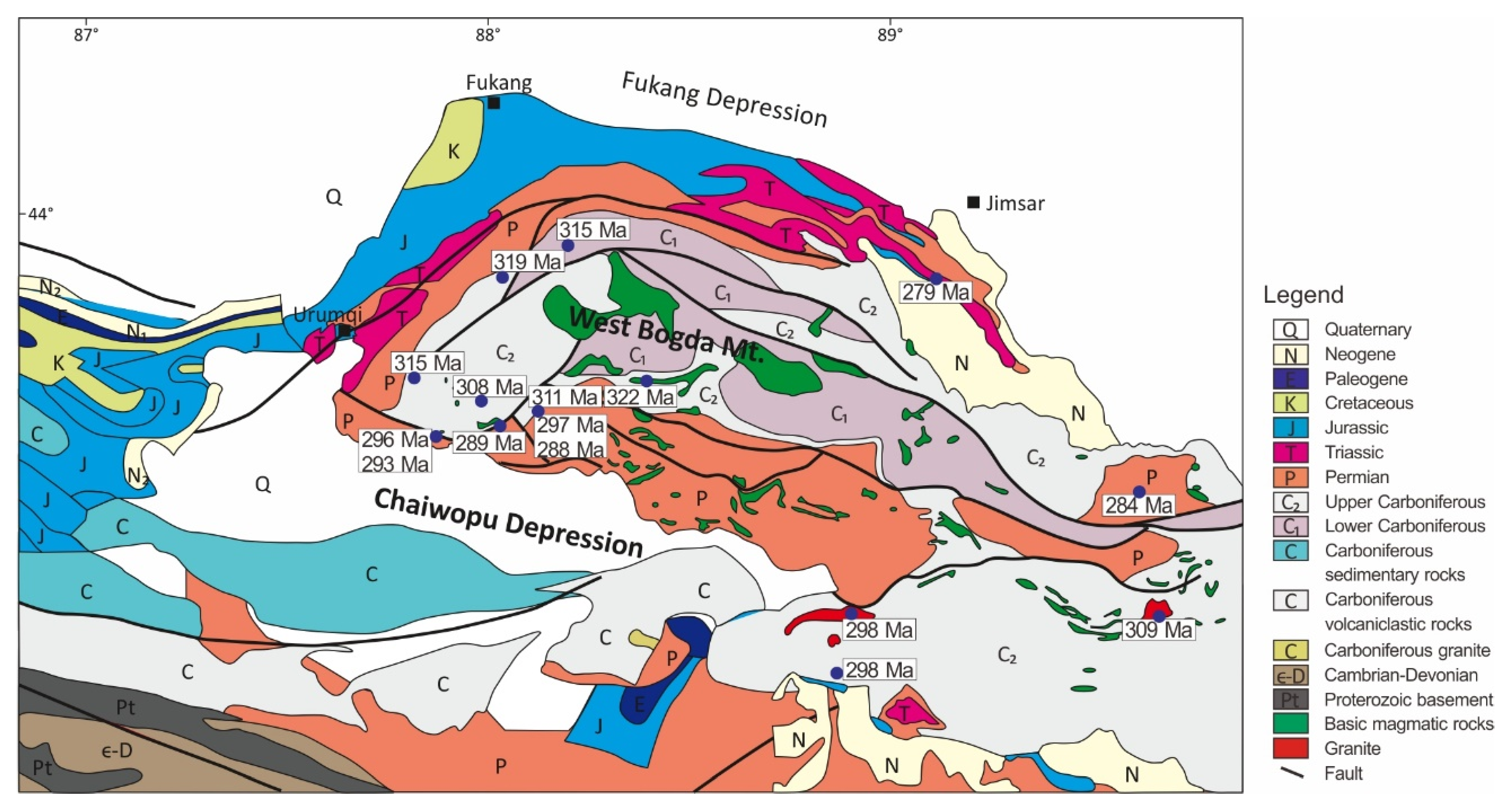
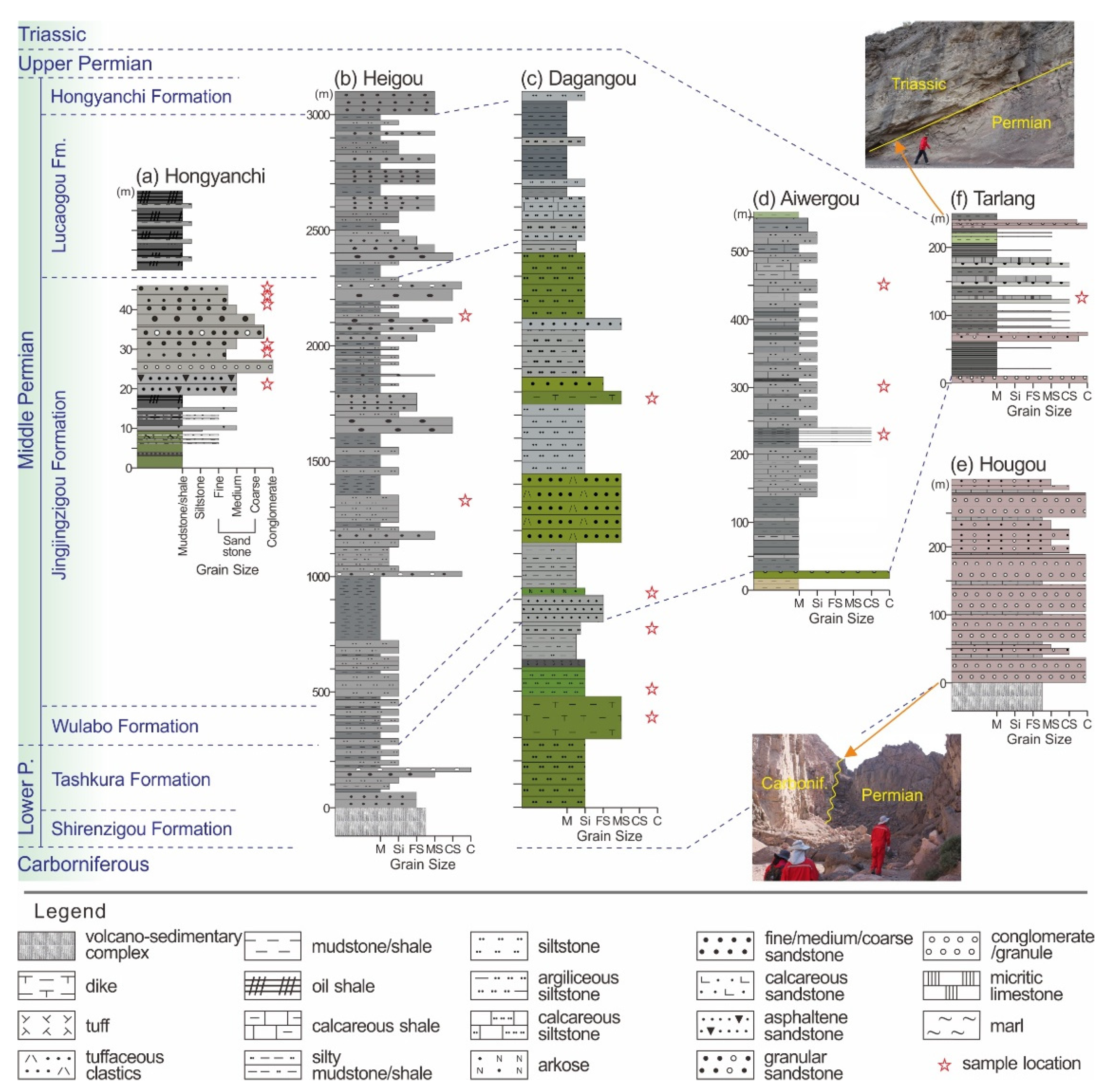
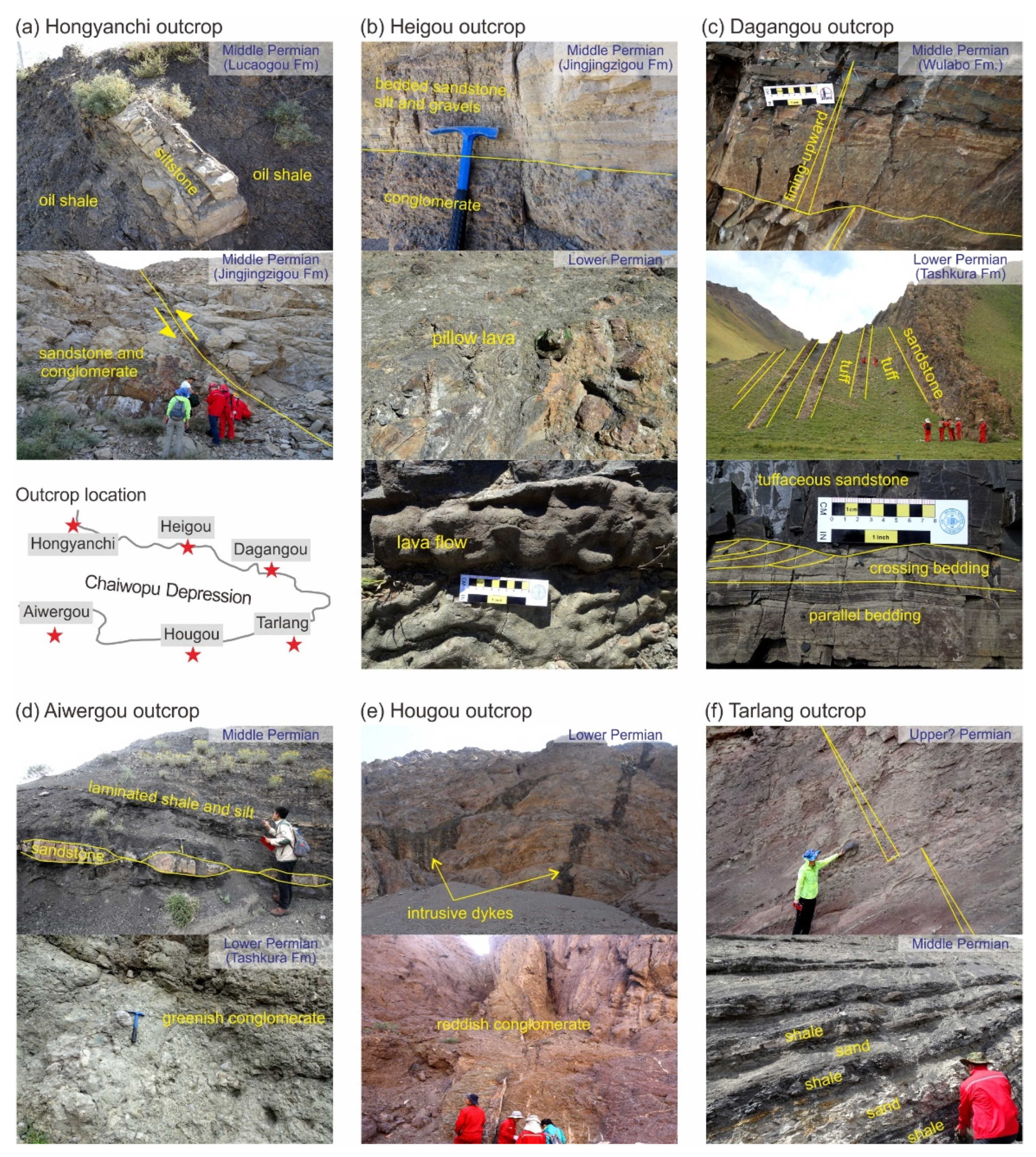

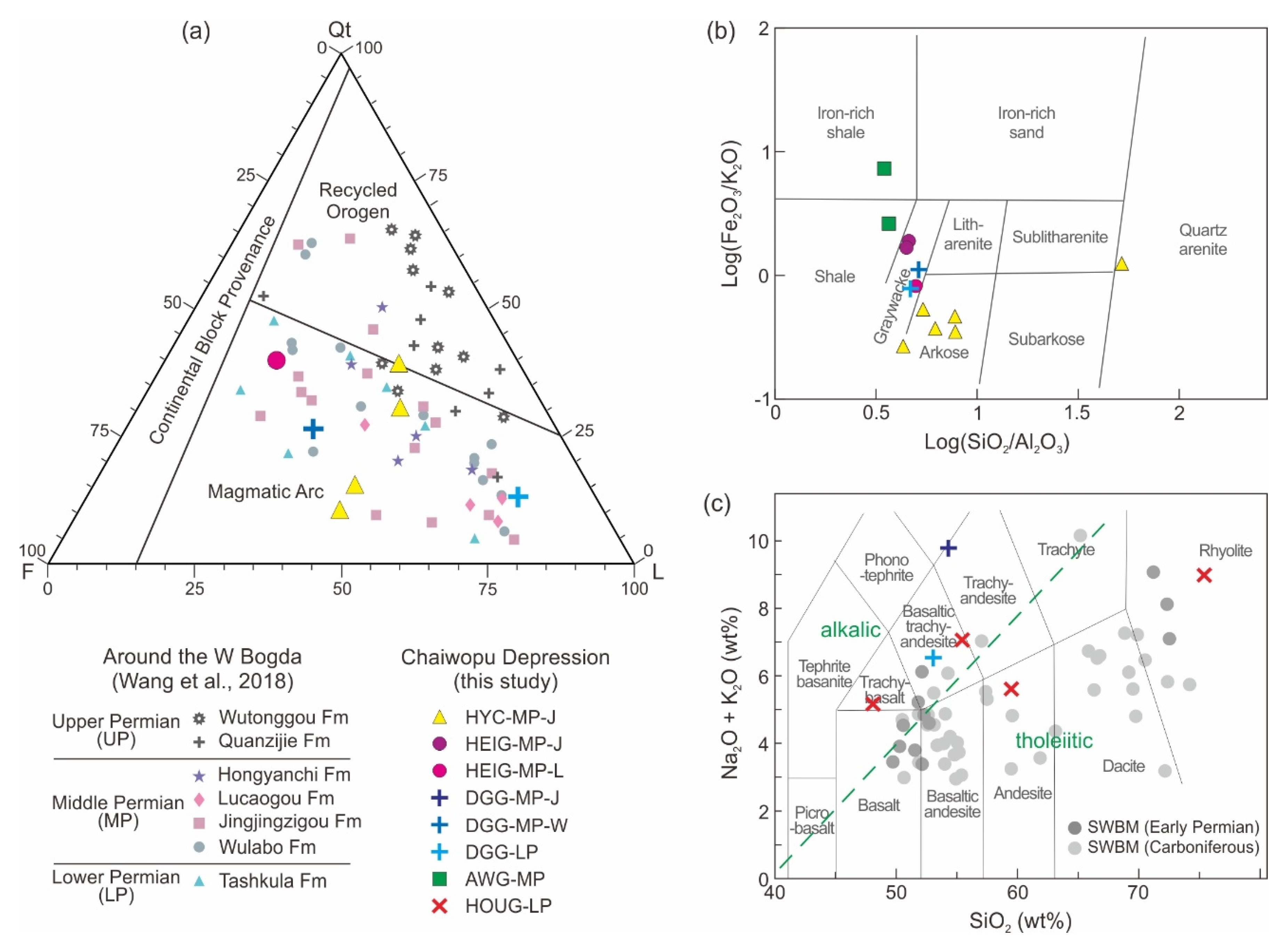
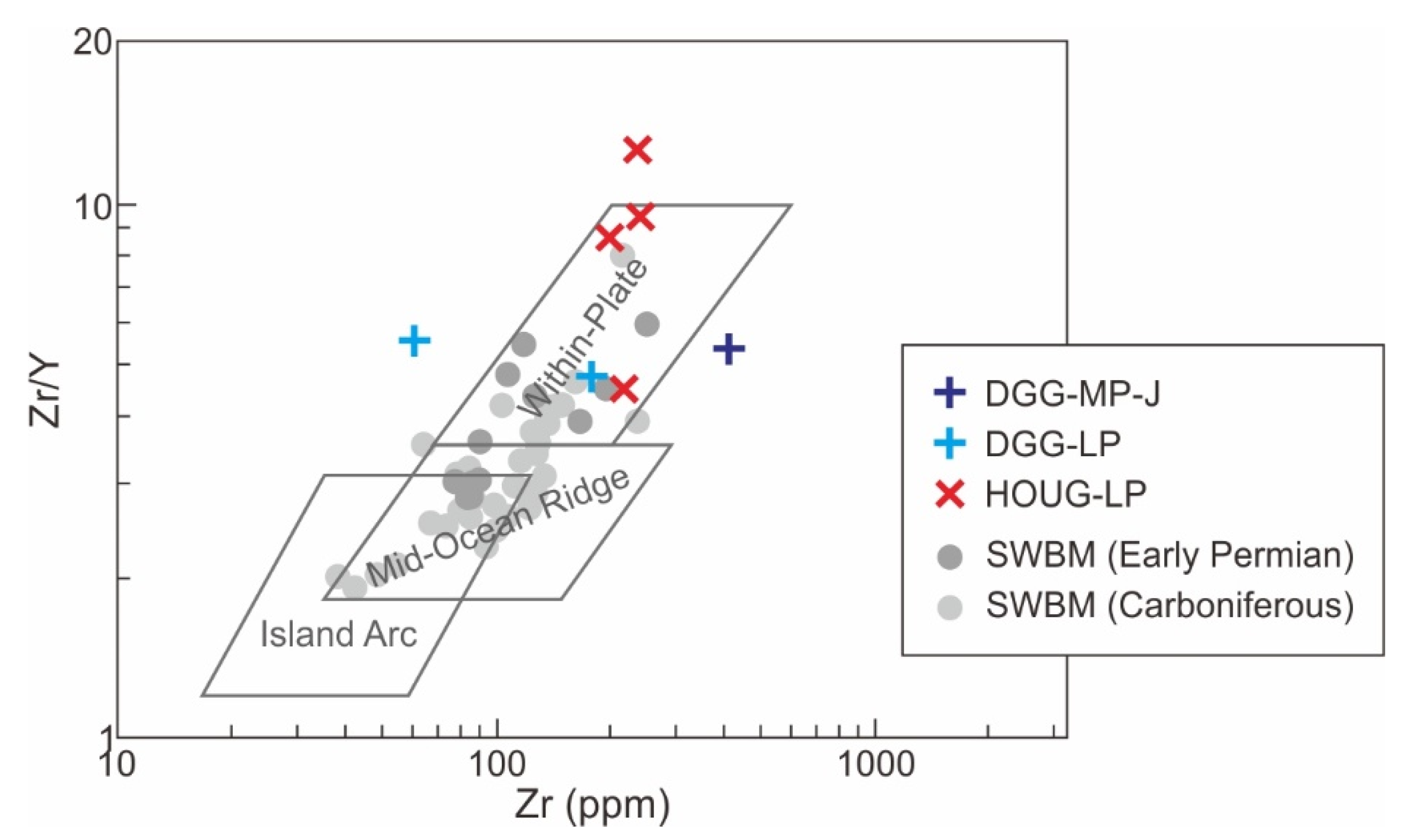
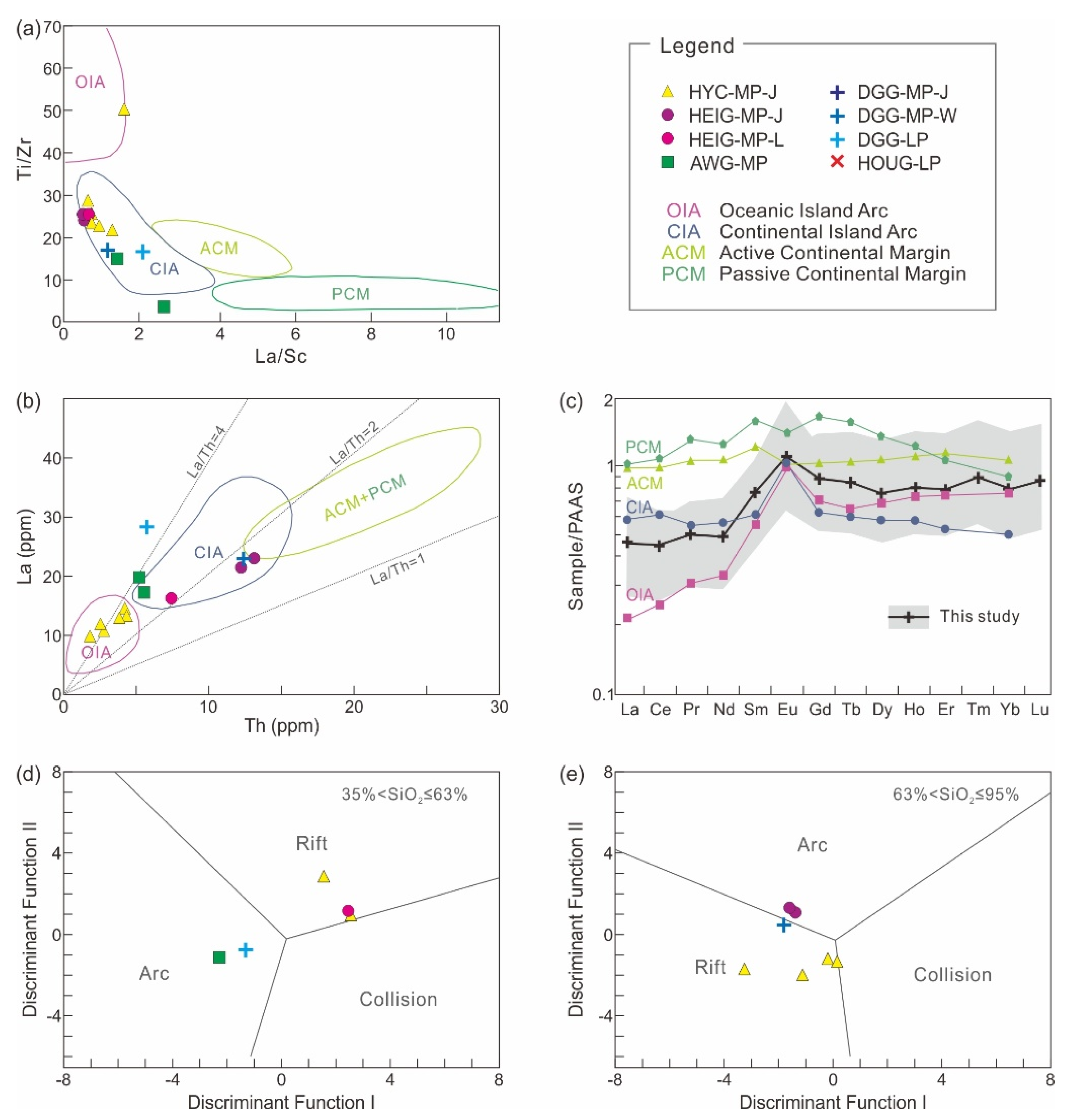
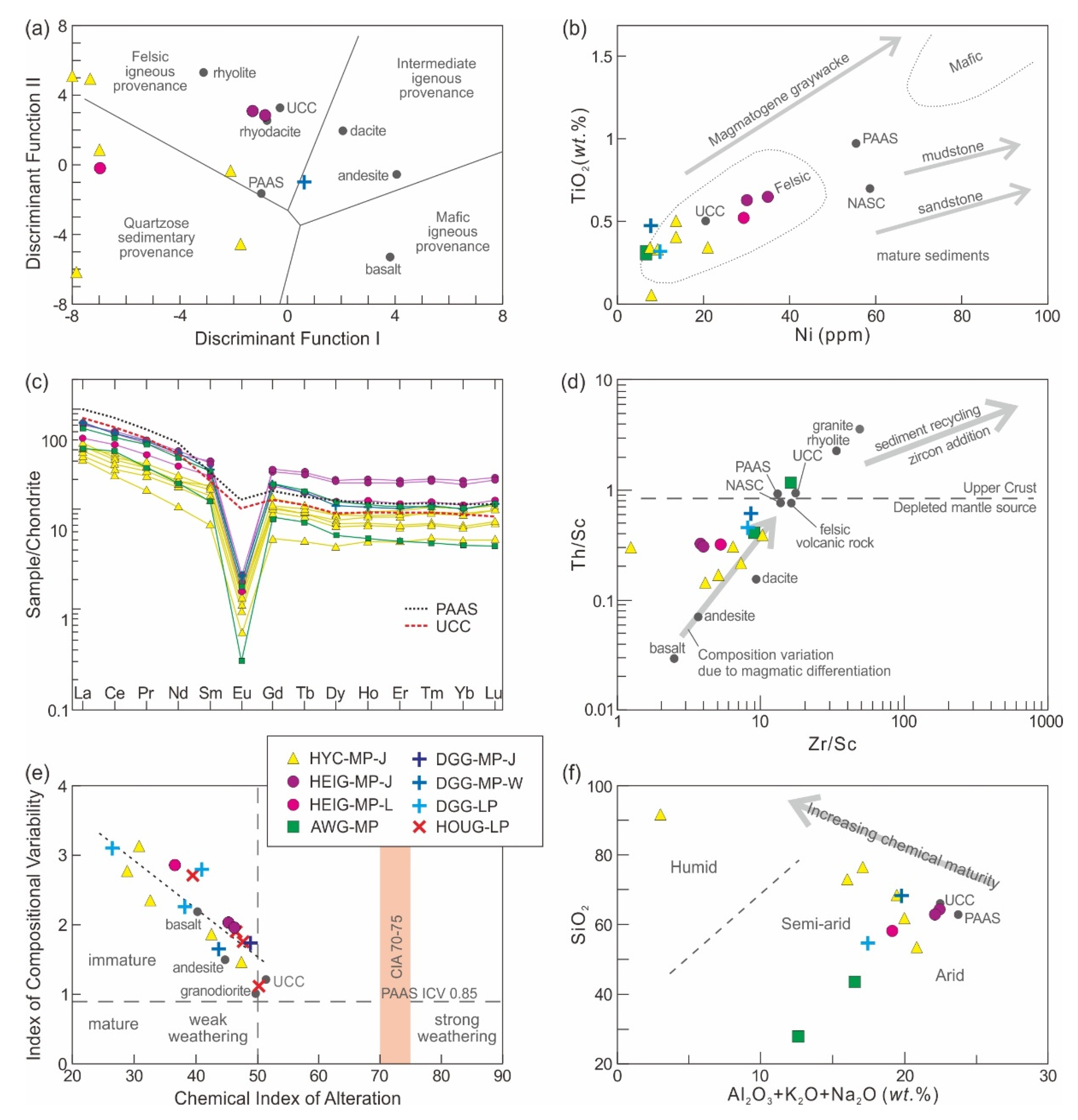
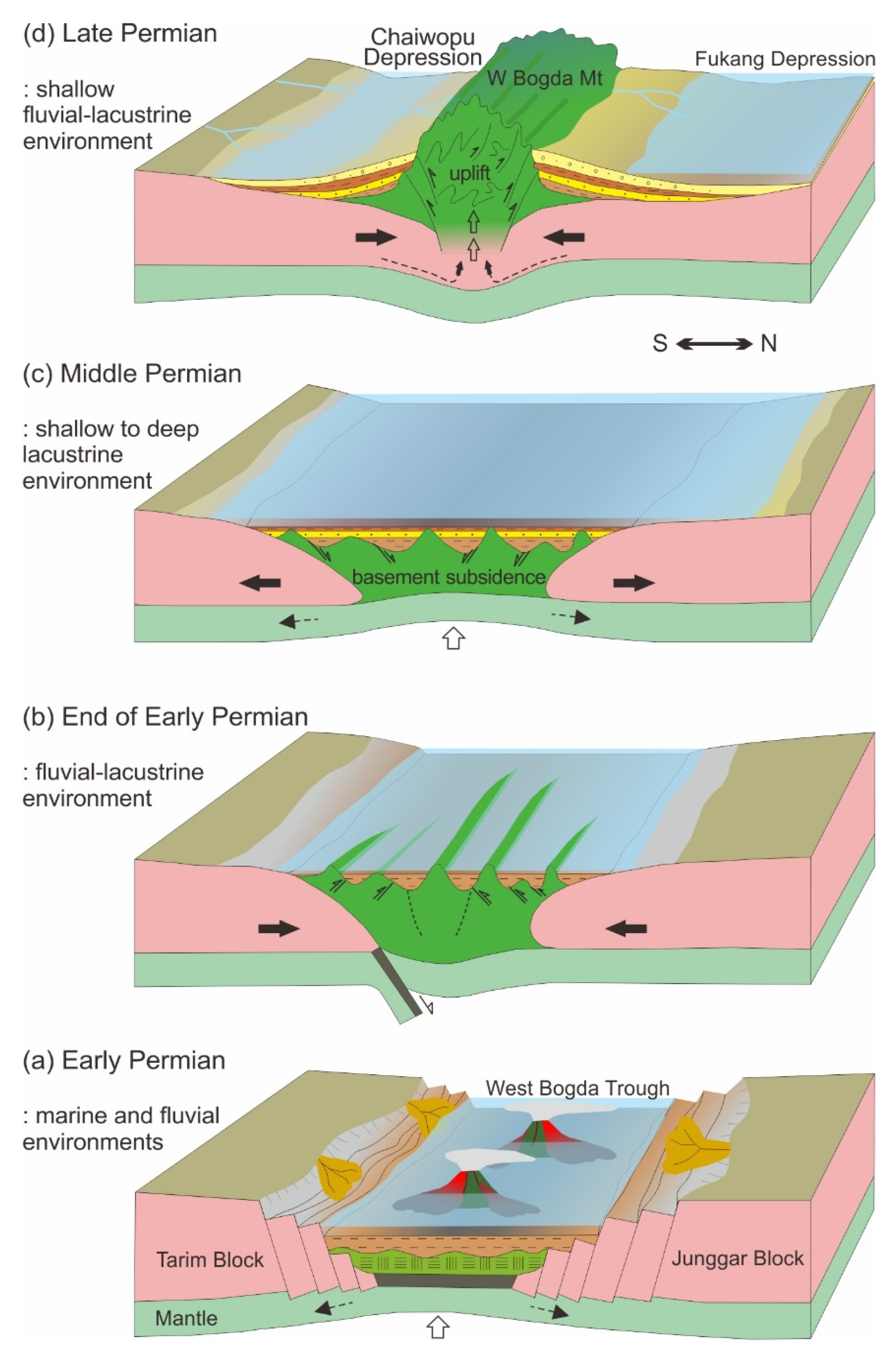
Publisher’s Note: MDPI stays neutral with regard to jurisdictional claims in published maps and institutional affiliations. |
© 2021 by the authors. Licensee MDPI, Basel, Switzerland. This article is an open access article distributed under the terms and conditions of the Creative Commons Attribution (CC BY) license (https://creativecommons.org/licenses/by/4.0/).
Share and Cite
Liu, S.; Lee, E.Y.; Zhang, J.; Wagreich, M.; Zhao, L.; Liu, H. Tectono-Paleogeographic Impact on the Permian Depositional Environment and Provenance around the Chaiwopu Depression in the Southern Junggar Basin, NW China. Minerals 2021, 11, 1237. https://doi.org/10.3390/min11111237
Liu S, Lee EY, Zhang J, Wagreich M, Zhao L, Liu H. Tectono-Paleogeographic Impact on the Permian Depositional Environment and Provenance around the Chaiwopu Depression in the Southern Junggar Basin, NW China. Minerals. 2021; 11(11):1237. https://doi.org/10.3390/min11111237
Chicago/Turabian StyleLiu, Shasha, Eun Young Lee, Jinliang Zhang, Michael Wagreich, Leqiang Zhao, and Hui Liu. 2021. "Tectono-Paleogeographic Impact on the Permian Depositional Environment and Provenance around the Chaiwopu Depression in the Southern Junggar Basin, NW China" Minerals 11, no. 11: 1237. https://doi.org/10.3390/min11111237
APA StyleLiu, S., Lee, E. Y., Zhang, J., Wagreich, M., Zhao, L., & Liu, H. (2021). Tectono-Paleogeographic Impact on the Permian Depositional Environment and Provenance around the Chaiwopu Depression in the Southern Junggar Basin, NW China. Minerals, 11(11), 1237. https://doi.org/10.3390/min11111237







